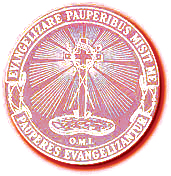Each religious congregation has its coat of arms, also called arms, armorial bearings or escutcheon. In a symbolic way, they express the identity of the mission of an institute. Father de Mazenod, in his many writings, gives no indication as to the origins of our coat of arms. Without doubt, he drew inspiration from the coat of arms of the Redemptorists who, among others, have a cross against which are leaning the lance and the sponge, much like that of the Lazarists who have the motto: “Evangelizare pauperibus misit me.”
On the oblation formula sheets of the Founder and Father Tempier of November 1, 1818, we already find sealed on the paper a coat of arms, oval in form, which are made up of a cross in the centre against which are leaning the lance and the sponge (on the end of a reed). The cross is thrust into the ground, the crown of thorns and the inscription INRI are set in the middle. The cross, without radiating aura or shafts of light stands on a rocky promontory. In a circle around we read the motto: “Pauperes evangelizantur.” At the bottom, there is the seal: M.P. (Missionarii Provinciae).
In 1825-1826, the Congregation of the Missionaries of Provence took the name of Oblates of Saint Charles, and later on, Oblates of Mary Immaculate. On the Recueil de cantiques(Collection of hymns) of 1826, we still see the initials M. P. and a few minor changes: now, the oval has become a circle, the rocky promontory has been replaced by a little flower garden. There is a radiating aura and the words Evangelizare pauperibus misit me, are added to Pauperes evangelizantur.

After the approbation of the Rules in 1826, the General Chapter held in Marseilles from the 10th to the 13th of July decided not to change the coat of arms. A few changes were subsequently made and these changes appeared on the frontispiece of the 1827 edition of the Rules. M. P. is replaced by O.M.I., the lance and the reed are no longer thrust into the little flower garden, the rays of the radiant aura are made less numerous and less dense. We find these coats of arms on many Oblate works up until 1891.
From 1891 to 1847, numerous secondary changes appeared. The General Chapter of 1947 decided to put an end to the arbitrary variations of our coat of arms. They obliged a return to the arms of 1891. This decision was promulgated in circular no. 248, dated November 1, 1947. (Circulaires administratives, vol. V, p. 195-196)
The General Chapter of 1972 created a “logo” frequently used since then, one which often replaces the Founder’s coat of arms and that of the 1947 Chapter. It no longer clearly indicates the mission of the Congregation such as desired and expressed by Father de Mazenod.
In the works of Fathers Yenveux and Boisramé, we find the significance of the various elements of the coat of arms: the cross, the instruments of the passion, the little flower garden, the inscription INRI (Jesus Nazarenus Rex Judaeorum), the motto, Evangelizare pauperibus misit me. Pauperes evangelizantur, the initials, O.M.I.
Writing on this subject, Father Giorgio Cosentino concluded his article with these words: “From everything we have just said, it is evident that the coat of arms of the Congregation are the coat of arms of missionaries with, however, an allusion to Mary as indicated by the initials, O.M.I. The Oblate of Mary Immaculate as presented to us by the coat of arms is the missionary to the poor. His work is the work of Jesus Christ. His motto is the same as that of Jesus. His emblem is the very cross of Jesus, a redemptive, radiant cross which will, with the grace and salvation of Jesus, extend to the ends of the earth to the most abandoned souls.”
Yvon Beaudoin, o.m.i.
